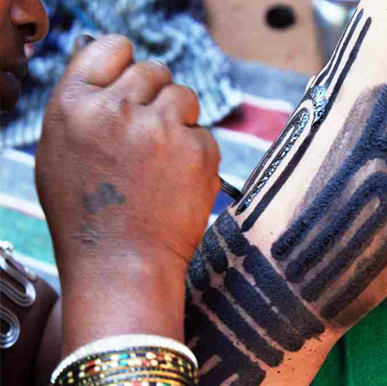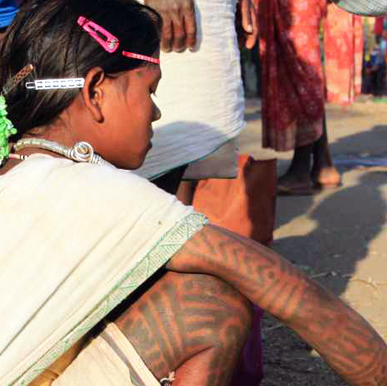Stories from the Road
"At times the girls arrive early and catch me by my bedside. They won't stop harassing me till I am ready and get down to work. And then they would quarrel to get one done first," says Mangala. If it is a girl who is getting her first tattoo, it doesn't take much time. But when it comes to more elaborate work on the older ones, Mangala can tattoo only two clients per day with a lunch break in between. After the design is completed, it is washed with cow-dung water, a paste of turmeric and mustard oil is applied and left to heal. Interestingly no cash payments are made. "For their services, a Godnaharin receives rice, turmeric, oil, chilies, salt and clothes," says Mangala. And when she is not travelling to tattoo, that's when life gets very difficult. "I wake up before sunrise, cook for the family, ready my son for school and head out to work as a manual labour if there is any work happening in and around the village. If not, I stay at home and hope for a better tomorrow," says Mangala. "We were finally about to get down to business. Mangala was preparing the concoction of the ink to be used to draw the design on my arm with a small stick. There was a bowl of water and eight fresh needles bound together to prick on the design for the next 60 minutes," says Kuntil. The concoction was burnt skin of a snake mixed with ramtilla (Guzotia Abyssinica) oil.
"The design that you have chosen is called chakmak and the story goes back to those times when our ancestors discovered fire by rubbing stone flints. There are also elements of our daily life such as agricultural tools, the hearth and the hooks used for fishing in the design. The dots represent food grains and prosperity," says Mangala. Baiga tattoos are extremely intricate and the motifs are a reflection of the environment they live in, the flora, fauna and tools used in daily lives. Mangala also showed me two motifs which the Baigas believe act as talismans. "On the sole of the right foot the Baiga women tattoo a triangular device that represents the earth and believe it will prevent the foot from getting hurt when they walk about barefoot. Then there are these foot five dots, one on each toe, and a line is drawn round the foot from the big toe to the little toe. This is the symbol of the elephant god which they believe enables them to lift heavy weight," says Mangala.
"When I reached Mangala's house that morning she didn't have a single penny. Yet she sent someone to get milk and biscuits with the promise to the shop keeper that she will pay later and served us tea. And while she was about to finish my tattoo she asked her father 'they (we) must be hungry. Will they have lunch with us? but we have only a little rice and chutney. Will they like it?'. A failed marriage, ailing parents who she has to support and the hardship of having to work as a manual labour to make ends meet hasn't deterred her to play the perfect host. Mahatma Gandhi rightly said that India lives in its villages," says Kuntil.

